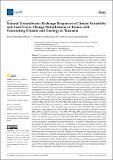| dc.description.abstract | The response of aquifers with contrasting climate and geology to climate and land cover change perturbations through natural groundwater recharge remains inadequately understood. In Tanzania and elsewhere in the world, studies have been conducted to assess the impact of climate change and variability, and land use/cover changes on stream flow using different models, but similar studies on groundwater dynamics are inadequate. This study, therefore, examined the influence of land use/cover and climate dynamics on natural groundwater recharge in basins with contrasting climate and geology in Tanzania, applying the modified soil moisture balance method, coupled with the curve number (CN). The method hinges on the balance between the incoming water from precipitation and the outflow of water by evapotranspiration. The different parameters in the soil moisture balance method were computed using the Thornthwaite Water Balance software. The potential evapotranspiration (PET) was calculated using the daily maximum and minimum temperatures, utilizing two-temperature-based PET methods, Penman–Monteith (PM) and Hargreaves–Samani (HS). The rainfall data were obtained from the gauging stations under the Tanzania Meteorological Agency and some additional data were acquired from climate observatories management by water basins. The results show that there has been a quasi-stable CN in the Singida semi-arid, fractured crystalline basement aquifer (74.2 in 1997, 73.64 in 2005, and 73.87 in 2018). In the Kimbiji, humid, Neogene sedimentary aquifer, the CN has been steadily increasing (66.69 in 1997, 69.08 in 2008, and 71.42 in 2016), indicating the rapid land cover changes in the Kimbiji aquifer as compared to the Singida aquifer. For the Kimbiji humid aquifer, the PET calculated using the Penman– Monteith (PM) method for the 1996/1997, 2007/2008, and 2015/2016 hydrological years were 1156.5, 1079.5, and 1143.9 mm/year, respectively, while for the Hargreaves–Samani (HS) method, the PET was found to be 1046.1, 1138.3, and 1204.4 mm/year for the 1996/1997, 2007/2008, and 2015/2016 hydrological years, respectively. For the Singida semi-arid aquifer, the PM PET method resulted in 2083.3, 2053.6, and 1875.4 mm/year for the 1996/1997, 2004/2005, and 2017/2018 hydrological years, respectively. The HS method produced relatively lower PET values for the semi-arid area (1839.4, 1814.7, and 1710.2 mm/year) for the 1996/1997, 2004/2005, and 2017/2018 hydrological years, respectively. It was equally revealed that the recharge and aridity indices correspond with the PET calculated using two temperature-dependent methods. The decline of certain land covers (forests) and increase in others (built-up areas) have contributed to the increase in surface runoff in each study area, possibly resulting in the decreasing trend of groundwater recharge. An overestimation of the PET using the HS method in the Kimbiji humid aquifer was observed, which was relatively smaller than the overestimation of the PET using the PM method in the Singida semi-arid aquifer. Despite the difference in climate and geology, the response of the two aquifers to rainfall is similar. The combined influence of climate and land cover changes on natural groundwater recharge was observed to be prominent in the Kimbiji aquifer, while only climate variability appreciably influences natural groundwater recharge in the Singida semi-arid aquifer. El Nino and the Southern Oscillation as part of the climate variability phenomenon dwarfed the time lags between rainfall and recharge in the two basins, regardless of their difference in climate and geology | en_US |

